Aquarium (sometimes also called Water Fun) is a spatial awareness logic puzzle. It shares some similarities with Thermometers, but make no mistake, this puzzle is its own thing with some unique challenges.
In a hurry? Jump to: Rules / Tips / Worked Example / Video Tutorial / Free Puzzle Downloads / Books
Here’s what a small example puzzle looks like:
The aim of the puzzle is to fill the aquariums (regions delimited by bold lines) such that the number of filled cells matches the clue numbers shown outside the grid. Water always finds its level, so the water level in connected regions must match.
Here’s what our small example puzzle looks like once it’s been solved:
Solving Aquarium puzzles is, much like Thermometers, about exclusion and forced placement. Here are some tips to help you get started, and then we’ll work through an example puzzle from start to finish.
Now you know how Aquarium works, we can put it into practice and work through a full size puzzle. There is rarely a single path to solving a given puzzle, so this is not the only way to solve this one, only a single possible way to do so. Indeed, I’m going to deliberately bypass some obvious steps in order to demonstrate some techniques.
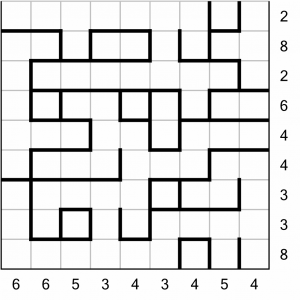
This is the grid we are going to work through. It’s a Level 1 puzzle which is easy enough to solve but should give you a grasp of the basics. There are lots of places to begin, but we’ll start with the easiest of all, which is probably the two rows labelled with the clue number of 2.
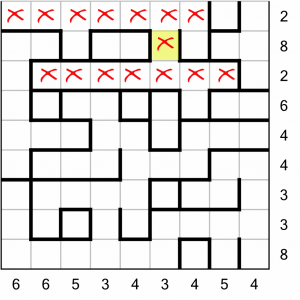
Both of those ‘2’ rows have horizontal sections of aquarium that are considerably larger than two cells, therefore they cannot be filled. We can mark them with Xs to exclude them.
By implication, we can also exclude the cell highlighted in yellow – there’s no way that could contain water if those below it are empty.
Now we know how to complete the top row of the puzzle…
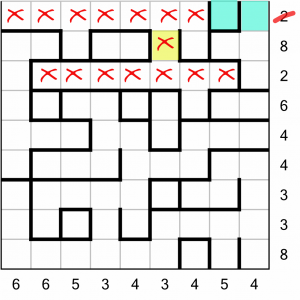
…as there are only two cells remaining. That completes the row, so we strike out the clue number.
Of course, that cell in the top right corner can’t be filled on its own – the water cannot simply float there! We have to fill the rest of the aquarium beneath it....
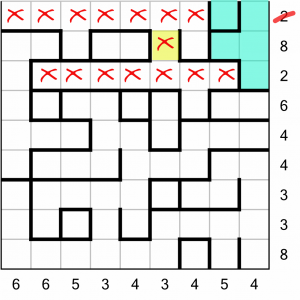
...like so.
Moving on, we know we can fill all the other empty cells in the ‘8’ row.
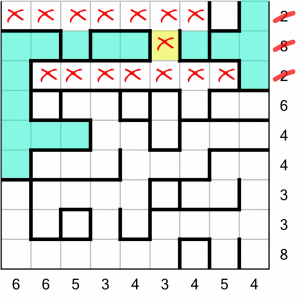
That’s completed the row. And because we had to back-fill the aquarium at the far left, it’s also meant we’ve completed the ‘2’ row beneath it.
Where next? We have a few options, but let’s go and exclude some more cells.
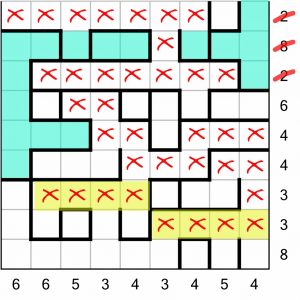
Excluding the two yellow areas for the two ‘3’ rows (because they are wider than three cells) lets us knock out a whole load of other cells by implication.
That’s going to let us complete some more rows…
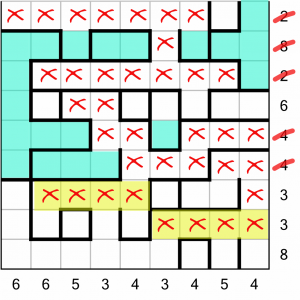
…specifically, the two ‘4’ rows in the middle.
Now, let’s have a look at the ‘6’ row.
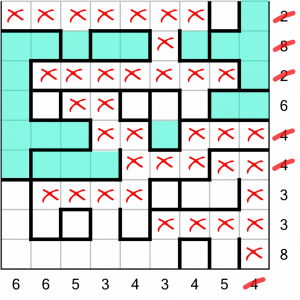
Although we don’t know all the cells that need to be populated to complete that row, we do know that the 2-cell region must be filled. There’s no way to complete that row without filling it. So we can fill it, which incidentally lets us strike off the end column as being complete. That means we can also put an X in the bottom-right cell.
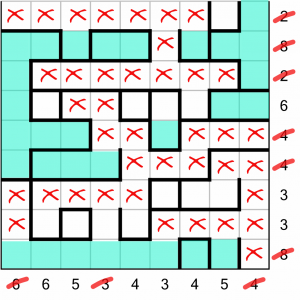
That lets us complete the bottom ‘8’ row, which in turn means we complete the first column (and can strike out the two remaining cells in it). We can also strike out the ‘3’ column as complete.
Finishing the puzzle now is easy, as it’s just a case of filling in the last few cells to meet the column and row targets.
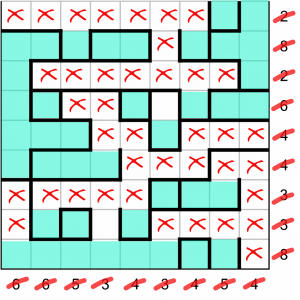
And that’s it – all done. Ready to have a go yourself? Read on!
We’ve put together a taster of four puzzles for you, including the example above. You can download and print the PDF below. Solutions are included, but no cheating!
Finished the taster and want more Aquarium in your life? No problem! Get 120 carefully crafted puzzles set over seven levels in Puzzle Weekly Presents: Aquarium – it's great value!
Prefer an instant dose of Aquarium fun? Check out Puzzle Express Volume #6. It contains 70 unique puzzles in our special dual-format, with sections for both printing and solving on screen. You can download it in seconds...
We also include Aquarium in Puzzle Weekly from time to time. Puzzle Weekly is our free weekly puzzle magazine – find out more, and get your copy, here.